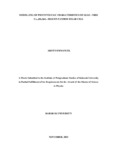| dc.description.abstract | The full potential of perovskite ‒ silicon tandem solar cells is yet to be realised despite its power conversion efficiency being higher than all other solar cell technologies. To optimize and leverage on this new technology, several techniques and materials are explored. Silicon and perovskite materials are used in several photovoltaics and optoelectronics applications. This research study primarily focuses on the simulation of perovskite ‒ silicon tandem solar cells and investigated the photovoltaic characteristics by using the open-source solar cell capacitance simulator (SCAPS-1D) software. The top cell is the perovskite cell and the bottom is the silicon cell. The top cell was simulated independently with the structure ITO/Cs0.8Rb0.2SnI3/PCBM/BCP/Al with an efficiency of 2.25 %. The effect of varying thickness, defect density, and doping concentration of the absorber layer, variation of Electron Transport Layer (ETL) thickness and doping concentration, and influences of the work function of Cl ‒ doped and undoped ‒ Indium-doped tin oxide (ITO) front contact of the tin-based perovskite solar cells were studied. Optimum open circuit voltage, short circuit current density, fill factor and efficiency are determined. The bottom cell was simulated independently using the structure Au/c-Si (n)/c-Si (p)/c-Si (p+)/Al with an efficiency of 26.68 %. The monolithic Cs0.8Rb0.2SnI3 perovskite– silicon tandem solar cell of the architecture ITO/Cs1-xRbxSnI3/c-Si (n)/c-Si (p)/c-Si (p+)/Al performance was analyzed by varying the thickness, doping concentration, and defect density of the active layers. Optimized parameters for the tandem cell were as follows: top perovskite layer thickness , doping concentrations and defect density , and bottom silicon absorber layer thickness , doping concentrations , defect density , with Cl doped ‒ ITO of work function as front contact. Optimized outcomes of efficiency, open-circuit voltage, short circuit current density, and fill factor were realized for the lead-free Cs1-xRbxSnI3 ‒ silicon 2T tandem solar cell. | en_US |

